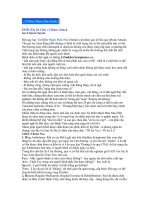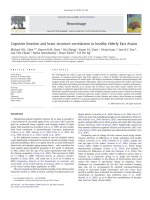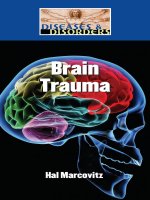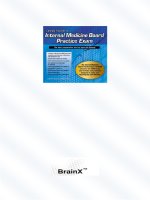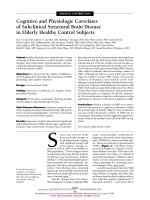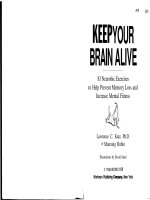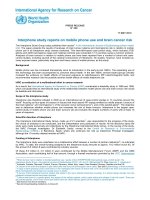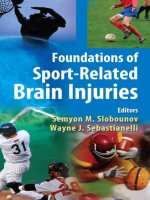coffee brain
Bạn đang xem bản rút gọn của tài liệu. Xem và tải ngay bản đầy đủ của tài liệu tại đây (367.43 KB, 6 trang )
Chronic coffee and caffeine ingestion effects on the cognitive function and
antioxidant system of rat brains
Renata Viana Abreu
a,b
, Eliane Moretto Silva-Oliveira
a
, Márcio Flávio Dutra Moraes
b
,
Grace Schenatto Pereira
b
, Tasso Moraes-Santos
a,
⁎
a
Laboratório de Nutrição Experimental (LNE), Faculdade de Farmácia, Universidade Federal de Minas Gerais, Av. Antônio Carlos, 6627, Pampulha, Belo Horizonte, Minas Gerais,
31270-901, Brazil
b
Núcleo de Neurociências, Departamento de Fisiologia e Biofísica, Instituto de Ciências Biológicas, Universidade Federal de Minas Gerais, Av. Antônio Carlos, 6627, Pampulha, Belo
Horizonte, Minas Gerais, 31270-901, Brazil, 31270-901
abstractarticle info
Article history:
Received 8 February 2011
Received in revised form 10 May 2011
Accepted 8 June 2011
Available online 15 June 2011
Keywords:
Coffee
Caffeine
Learning and memory
Endogenous antioxidant system
Coffee is a popular beverage consumed worldwide and its effect on health protection has been well studied
throughout literature. This study investigates the effect of chronic coffee and caffeine ingestion on cognitive
behavior and the antioxidant system of rat brains. The paradigms of open field and object recognition were
used to assess locomotor and exploratory activities, as well as learning and memory. The antioxidant system
was evaluated by determining the activities of glutathione reductase (GR), glutathione peroxidase (GPx) and
superoxide dismutase (SOD), as well as the lipid peroxidation and reduced glutathione content. Five groups of
male rats were fed for approximately 80 days with different diets: control diet (CD), fed a control diet; 3%
coffee diet (3%Co) and 6% coffee diet (6%Co), both fed a diet containing brewed coffee; 0.04% caffeine diet
(0.04%Ca) and 0.08% caffeine diet (0.08%Ca), both fed a control diet supplemented with caffeine. The
estimated caffeine intake was approximately 20 and 40 mg/kg per day, for the 3%Co–0.04%Ca and 6%Co–0.08%
Ca treatments, respectively. At 90 days of life, the animals were subjected to the behavioral tasks and then
sacrificed. The results indicated that the intake of coffee, similar to caffeine, improved long-term memory
when tested with object recognition; however, this was not accompanied by an increase in locomotor and
exploratory activities. In addition, chronic coffee and caffeine ingestion reduced the lipid peroxidation of brain
membranes and increased the concentration of reduced-glutathione. The activities of the GR and SOD were
similarly increased, but no change in GPx activity could be observed. Thus, besides improving cognitive
function, our data show that chronic coffee consumption modulates the endogenous antioxidant system in
the brain. Therefore, chronic coffee ingestion, through the protection of the antioxidant system, may play an
important role in preventing age-associated decline in the cognitive function.
© 2011 Elsevier Inc. All rights reserved.
1. Introduction
There is a general agreement on the existence of a normal
cognitive decline from early to late adulthood and that disorders, such
as Alzheimer's disease (AD), are associated with an overall impair-
ment of higher functions and cognitive faculties, one of which is a
symptomatic loss of memory (Bertaina-Anglade et al., 2006).
Evidence suggests that a progressive accumulation of oxidative
damage to the brain may well lead directly to such age-associated
cognitive losses (Head, 2009; Martin and Grotewiel, 2006). Taking
these arguments into consideration, the oxidative damage theory was
proposed in an attempt to explain the underlying biological
mechanisms of age-associated cognitive impairment. This theory
postulates that the age-dependent accumulation of oxidative damage
to macromolecules in the brain causes a progressive functional
deterioration of cells, tissues, and organ systems, which commonly
appear as functional senescence (Weinert and Timinas, 2003).
Oxidative damage to lipids, proteins, and DNA occurs primarily
through reactive oxygen species (ROS) actions. The brain, in
particular, is highly vulnerable to ROS, as it consumes approximately
20% of the body's total oxygen and contains a high content of
polyunsaturated fatty acids and lower levels of endogenous antiox-
idant activity as compared to other tissues (Halliwell and Gutteridge,
1985). A wide array of enzymatic and non-enzymatic antioxidant
defenses exist, including superoxide dismutase (SOD), glutathione
peroxidase (GPX), catalase (CAT), glutathione (GSH), beta-carotene,
ascorbic acid (vitamin C), and alpha-tocopherol (vitamin E). A balance
can be identified between both the activities and the intracellular
Pharmacology, Biochemistry and Behavior 99 (2011) 659–664
⁎ Corresponding author at: Faculdade de Farmácia, Universidade Federal de Minas
Gerais. Departamento de Alimentos—Sala 2099-B3, Av. Antônio Carlos, 6627, Pampulha,
31270-901—Belo Horizonte, MG, Brazil. Tel.: +55 31 3409 6917; fax: +55 31 3409
6989.
E-mail address: (T. Moraes-Santos).
0091-3057/$ – see front matter © 2011 Elsevier Inc. All rights reserved.
doi:10.1016/j.pbb.2011.06.010
Contents lists available at ScienceDirect
Pharmacology, Biochemistry and Behavior
journal homepage: www.elsevier.com/locate/pharmbiochembeh
levels of these antioxidants which are essential for the survival of
organisms and their health (Matés and Sánchez-Jiménez, 1999).
In recent years, based on this possible link between oxidative
damage and cognitive decline, there has been a growing interest in
studying diet bioactive compounds that delay or prevent cell damage,
provide symptomatic relief, and improve people's quality of life.
Coffee, a very popular beverage consumed worldwide, has been
extensively studied as a protective food, able to produce physiological
or metabolic effects on the human organism, adapting it to withstand
environment adversities. Research has shown that caffeine, a major
constituent of coffee, induces a broad spectrum of cellular and
pharmacological responses, such as the central nervous system and
motor activity stimulation (Fredholm et al., 1999), cognitive perfor-
mance improvement (Cunha and Agostinho, 2010), anxiety and sleep
disturbance (Nardi et al., 2009; Paterson et al., 2009), antioxidant
activity (Noschang et al., 2009; Shi et al., 1991), among others. Besides
caffeine, coffee contains a number of other substances—phenolic
polymers, chlorogenic acids, lipids, and terpenes—that have different
biological effects, such as antioxidant (Cho et al., 2009; Natella et al.,
2002), anticarcinogenic (Cavin et al., 2002), antimicrobial (Almeida
et al., 2006), and neuroprotection activities (Herraiz and Chaparro,
2006; Hwang and Jeong, 2008). Despite the known effects of coffee
isolated components, little is known about the effect of brewed coffee,
where functional interactions among components may well increase
or decrease individual action, rendering the beverage a potential
protective food against events that can lead to a decline in brain
functions. Evidence suggests that in humans there is a link between
chronic coffee/caffeine consumption and cognitive performance
(Ritchie et al., 2007; Santos et al., 2010). However, very little is
known about how coffee ingestion really affects cognitive function.
Therefore, the present study was carried out to assess the effect of
chronic coffee and caffeine ingestion on cognitive performance in rats
by modulating the endogenous antioxidant system of the brain.
2. Material and methods
2.1. Diets
The control diet was prepared using a mixture of 80% of a
powdered rat lab chow (Labina, Purina, Paulínia, SP, Brazil) and 20% of
powdered dog food (Bonzo, Purina, Paulínia, SP, Brazil). For every 90 g
of the mixture, 100 ml of a solution containing 4% commercial gelatin,
1% cornstarch, and 5% sugar in hot water was added. The formed
dough was pelleted and dried at 60 °C in a forced air oven (Nova Ética
420-D, Vargem Grande Paulista, SP, Brazil) for a time necessary to
return the diet weight to 100 g.
The present study used the Coffea arabica species, cultivated in the
southern regions of the state of Minas Gerais (Brazil), an exportation
type, grain with no defects, with an average granulation and
processed by toasting at a temperature of 160 °C for nearly 13 min,
at classification 45. The classification of the toasting point was
determined by using the Roast Color Classification System (AGTRON/
SCAA, 1995), according to the standards applied by the Brazilian
Coffee Industry Association (ABIC). The content of caffeine in coffee
powder was 12.5 mg caffeine/g of coffee (1.25%), determined by
HPLC.
Boiled, distilled water was added to milled toasted coffee at a
concentration of 3% w/v and 6% w/v. The suspension was centrifuged
(27 xg) for 10 min and the supernatant was collected (Centrifuge
Hitachi CR21, Hitachinaka, Japan). The diet supplemented with coffee
used the control diet as a basis. However, to this diet, 100 mL of 3% or
6% brewed coffee, containing the gelatin/starch/sugar solution
described above, was added to prepare the dough. Similarly, the
diet supplemented with caffeine was based on the control diet.
However, in this case, the solution formulated to prepare the dough
contained caffeine at the concentration of 0.04% or 0.08% (values
corresponding to caffeine content in the diet with coffee at 3% and 6%,
respectively). The remaining procedure for preparing the control diet
was then carried out. Control and experimental coffee and caffeine
diets were prepared weekly in the laboratory and stored at 4 °C.
2.2. Animals
Female Wistar rats were mated. During the gestation and lactation
period, they were fed a diet composed of rat lab chow (Labina, Purina,
Paulínia, SP, Brazil), enriched with 20% dog food (Bonzo, Purina,
Paulínia, SP, Brazil). Shortly after birth, when the pups were cleaned
and fed by the mother, eight per dam were maintained, with as many
male rats as possible. At weaning (21 days of life), the dams and
female pups were discarded. The male rats were randomly divided
into five groups (n=16), with one animal per cage: (1) control diet
(CD)—fed the control diet; (2) 3% coffee diet (3%Co)—fed a diet
containing 3% of brewed coffee; (3) 6% coffee diet (6%Co)—fed a diet
containing 6% of brewed coffee; (4) 0.04% caffeine diet (0.04%Ca),—
fed a control diet supplemented with 0.04% caffeine; and (5) 0.08%
caffeine diet (0.08%Ca)—fed a control diet supplemented with 0.08%
caffeine.
Water was offered ad libitum. Every other day, the dietary
consumption was determined by subtracting the weight of the
amount of food offered (in the two days before) from that not
ingested. The animal's body weight was monitored weekly.
At 90 days of life, the animals were subjected to two behavioral
tasks: open field and object recognition memory (novel object
preference). At approximately 100 days of life, the rats were sacrificed
by decapitation. The brain was processed for further biochemical
analysis of oxidative stress markers. The experimental protocol was in
accordance with the Ethical Principles for Animal Experimentation as
established by the Ethics Committee on Animal Experiments from the
Federal University of Minas Gerais, Brazil (protocol n
o
126/2007).
2.3. Behavioral test
Apparatus—Open field and novel preference tasks occurred in an
open-topped arena (50×50×40 cm) made of acrylic. The walls inside
the arena were surrounded with a black paper so that no external
stimuli could be seen during the experiment, and the floor of the
arena was divided into sixteen quadrants of equal size, using thin
indentation marks, into a 4×4 matrix of squares (12.5×12.5 cm). The
stimuli presented in the object recognition test were copies of objects
composed of plastic pieces (Gulliver, São Caetano do Sul, SP, Brazil)
that varied in shape, color, and size and were fixed to the floor of the
arena to avoid moving during tasks. After each trial, the objects were
thoroughly cleaned with a 75% ethanol solution to remove odor cues.
Prior to each behavioral test, the animals were placed in the testing
room 20 min before the task to allow habituation to the environment.
All tasks were performed between noon and 4 p.m. The observer
(unaware of the experimental group being tested) made direct visual
observations for both open field test and new subject preference task.
Open field—To analyze exploratory and locomotor activities, as well
as non-associative habituation memory, animals were placed in the
left rear quadrant of the arena described above. The observer took
note every time the animal crossed from one square to another
(number of crossings). The observer also counted the number of
rearings (“erect” posture sustaining weight on hind limbs, with fore
limbs elevated and head usually in profile). The number of line
crossings and the number of rearings were measured in 5 min periods
on 2 consecutive days.
Novel preference task—The animals were habituated to the arena
without stimuli for 20 min daily for 3 days before beginning the
behavioral test. The task consisted of an acquisition or sample phase,
followed by two preference tests, one after a delay of 90 min (short-
term memory) and another 24 h after the sample phase (long-term
660 R.V. Abreu et al. / Pharmacology, Biochemistry and Behavior 99 (2011) 659–664
memory). In the sample phase, duplicate copies (A1 and A2) of an
object were placed near the two corners at either end of one side of
the arena (15 cm from each adjacent wall). The animal was placed in
the arena facing the center of the opposite wall and allowed 5 min for
exploration. After 90 min, the animal was replaced in the arena,
presented with two objects in the same positions: one object (A3) was
a third copy of the set of the objects used in the sample phase, while
the other object was a novel object (B). Using two distinct
chronometers, the observer quantified the total time spent exploring
each object placed in the arena, within a 5-minute time window. The
second test phase was performed after 24 h, with a copy of the object
used in the sample phase (A4) and a new object (C) (Ennaceur and
Delacour, 1988).
The positions of the objects in the test and the objects used as
novel or familiar were counterbalanced between the animals.
Exploratory behavior of a particular object was defined as the
animal directing its nose toward the object at a distance of b2 cm. Any
other behavior, such as looking around while sitting on or resting
against the object, was not considered as exploration.
The discrimination index was calculated as the time spent by each
animal exploring the novel object divided by the total time spent
exploring both objects.
2.4. Biochemical analysis
Brain homogenate—After removing the cerebellum, the brain was
weighed, homogenized in 10 volumes (1:10 w/v) of sodium phos-
phate buffer at 50 mM plus KCl 140 mM, pH 7.4, and centrifuged at
750×g for 10 min (Centrifuge Hitachi CR21, Hitachinaka, Japan). The
supernatant was collected. Aliquots of 1.0 ml of all samples were
frozen in liquid nitrogen and subsequently stored in a freezer at
−70 °C until further processing.
Biochemical analysis—The lipid peroxidation index was deter-
mined according to Yagi (1984), whereas the glutathione (GSH)
content was determined according to Tietze (1969). The activity of
glutathione peroxidase was determined according to Paglia and
Valentine (1967), whereas the glutathione reductase was determined
according to Carlberg and Mannervik (1975). The superoxide
dismutase activity was determined according to Marklund and
Marklund (1974) and was based on the inhibition of pyrogallol auto
oxidation.
Measurements in all assays described were carried out in trip-
licate. The protein amount in all samples was determined according to
Lowry et al. (1951) and modified by Hartree (1972). All chemicals
used were of analytical grade and were purchased from Sigma
Chemical Co. (St. Louis, MO, USA).
2.5. Statistical analysis
Open field crossing, as well as memory data of rearing values and
object recognition, underwent ANOVA analysis. The significant
differences in the experimental values were determined using the
Duncan test and Bonferroni test, respectively.
ANOVA, followed by the Duncan test, was applied to biochemical
data. Values were considered statistically different at P b0.05.
3. Results
Diet supplemented with of 3% or 6% coffee extract and 0.04% or
0.08% caffeine, as compared to the control group, had no effect on the
rats' food consumption and body weight gain (Table 1).
The effect of diet supplementation with coffee or caffeine on the
rats' locomotor and exploratory activities was evaluated by an open
field test and is shown in Table 2. The intake of coffee or caffeine in the
diet, as compared to the control group, did not modify the number of
crossings and rearings in the open fi
eld test, indicating that the
presence of coffee or caffeine in the diet did not increase the explor-
atory activity of these animals. All experimental groups showed a
lower number of locomotor and exploratory activities on the second
Table 1
Diet ingestion and body weight gain in the rats.
Days
21 35 50 65 80 95
Food consumption (g)
CD 3.12±0.41 14.45±0.35 22.05±0.52 24.63±0.65 24.07±0.51 23.74±0.52
3%Co 3.77±0.46 14.23±0.58 23.08±0.53 25.48±0.79 25.79±0.56 23.47±0.65
6%Co 3.79±0.61 14.21±0.45 22.79±0.69 24.86±0.89 25.32±0.85 24.18±0.69
0.04%Ca 3.69±0.45 13.79±0.40 22.11±0.57 23.93± 0.55 24.51±0.42 23.63±0.53
0.08%Ca 3.89± 0.46 13.78±0.37 22.50 ±0.53 24.32±0.67 24.67±0.69 24.95 ±0.57
Body weight (g)
CD 48.66±1.12 125.16±2.39 230.48±4.55 316.24±6.55 370.41±7.11 395.21±7.95
3%Co 49.44±1.14 123.83±2.70 231.97±4.02 322.38±6.71 383.91±7.79 408.87±8.22
6%Co 48.01±1.21 121.07±2.23 225.94±3.67 312.82±7.13 374.85±7.90 398.11±7.90
0.04%Ca 47.75 ±1.19 120.60±2.17 225.01± 4.21 312.44±5.22 378.54±6.15 394.61±7.13
0.08%Ca 48.77 ±0.93 123.22±2.50 225.37± 4.86 319.50±5.34 374.94±6.77 403.09±7.26
All values are mean±SEM (n= 16). Although food consumption was assessed every couple of days and body-weight was assessed weekly, this table depicts six chosen periods (days
21, 35, 50, 65, 80 and 95) in order to show the time evolution of coffee/caffeine consumption per body weight along the experiment. No statistical difference was observed among the
groups on the same day (column) according to ANOVA and Duncan test (P b 0.05). CD fed lab chow; 3%Co fed 3% brewed coffee supplemented diet; 6%Co fed 6% brewed coffee
supplemented diet; 0.04%Ca fed 0.04% caffeine supplemented diet, and 0.08%Ca fed 0.08% caffeine supplemented diet. The estimated caffeine intake in these animals was about 20
and 40 mg/kg per day, for the 3%Co–0.04%Ca and 6%Co–0.08%Ca treatments, respectively.
Table 2
Open field: number of line crossings and number of rearings measured on 2 consecutive
days.
Groups Crossing Rearing
Day 1 Day 2 Day 1 Day 2
CD 62.3±4.0 47.5±4.2
⁎
13.9±1.2 8.1±1.1
⁎⁎
3%Co 61.7±4.1 38.0±4.9
⁎
9.3±1.3 6.3±0.6
⁎⁎
6%Co 65.4±4.5 42.8±2.4
⁎
12.9±1.4 5.4±0.8
⁎⁎
0.04%Ca 66.6±5.0 37.6±4.8
⁎
14.5±2.5 5.6±0.9
⁎⁎
0.08%Ca 62.1±3.7 38.1±4.3* 12.2±1.5 6.3±1.1
⁎⁎
All values are mean ±SEM (n=16). No statistical difference could be observed among
the groups on the same day (column) according to ANOVA and Duncan test (p b0.05). *
and ** indicate statistical difference (p b 0.05—Duncan test) in the same group from day
1 to day 2 in crossings and rearings, respectively. Crossing is defined as the number of
lines crossed by the animal in the arena. Rearing means the number of times the animal
stood in erect posture. CD represents the control group; 3%Co, the group supplemented
with 3% brewed coffee; 6%Co, the group supplemented with 6% brewed coffee; 0.04%Ca,
the group supplemented with 0.04% caffeine; and 0.08%Ca, the group supplemented
with 0.08% caffeine.
661R.V. Abreu et al. / Pharmacology, Biochemistry and Behavior 99 (2011) 659–664
day (lower number of crossings and rearings) (P b0.05), demonstrat-
ing the intactness of non-associative memory.
Neither coffee nor caffeine affected the total time of exploration in
both objects during the sample phase (data not shown). Fig. 1 shows
the performance of the groups in the sample and tests phases. There
was no statistical difference in the discrimination of objects between
the control group and groups supplemented with coffee or caffeine
during the test phase carried out after 90 min. However, in the test
phase performed after 24 h, the groups that ingested coffee (3% or 6%)
or caffeine (0.04% or 0.08%) diet performed better (higher discrim-
ination index) than did the control group.
The influence of coffee or caffeine on the cerebral antioxidant
system was also assessed. The results are summarized in Table 3.A
decrease in the content of TBARS (38%) in rats that ingested coffee or
caffeine in the diet was observed. On the other hand, coffee 6% and
caffeine 0.08% increased the GSH content by 60%. Diet supplementa-
tion with coffee or caffeine, as compared to the control group, induced
a significant increase (56%) in GR activity but did not affect the GPx
activity. Furthermore, an increase of 54% in superoxide dismutase
(SOD) activity in the groups fed a diet supplemented with 6% coffee
extract or caffeine could be observed.
4. Discussion
To evaluate the effect of chronic coffee ingestion on the cognitive
function and antioxidant system modulation, the animals received a
diet supplemented with brewed coffee (3% and 6%), and the
corresponding doses of 0.04% and 0.08% caffeine after weaning.
These diets were administered daily over the experimental life of the
animals. According to prior studies conducted by our research group
(Silva-Oliveira et al., 2010), and confirmed in this study, the addition
of coffee or caffeine to the rat's diet did not alter food intake nor did it
have any observable impact on the body weight of all groups studied.
The concentrations of 3% and 6% of coffee in the diet were based on
the literature (Huber et al., 2003; Turesky et al., 2003) and on data
from our research group that showed that the intake of coffee/caffeine
in this concentration range is capable to produce physiological and
metabolic effects in different biological systems of rats, without toxic
effects. However, these doses of coffee and caffeine used in this
experimental animal model study were raised according to daily
human consumption. The estimated caffeine intake in these animals
was approximately 20 and 40 mg/kg/day, for the 3% and 6% coffee
groups, respectively. By contrast, the estimated intake of caffeine in
humans drinking 2 cups of coffee daily is approximately 4 mg
caffeine/kg body weight, whereas for heavy coffee drinkers the
amount may reach 15 mg/kg (Turesky et al., 2003). But it is important
to consider, in addition to body weight, the rate of caffeine
metabolism, which is faster in rats than in humans, see pharmaco-
kinectis studies from Fredholm et al. (1999) for details. The caffeine
dose chosen (4 mg/kg/day) is also based on the report from van
Gelder et al. (2007) who found best protection in elderly cognition
decline by drinking 3 cups of coffee per day (375 ml/day), which is
around 255 mg/day of caffeine for an approximate body weight of 60–
70 kg.
The effects of coffee's individual components on learning and
memory have been reported in different animal models; however the
results of these studies are contradictory (Costa et al., 2008a, 2008b;
Kwon et al., 2010; Myoung-Eun et al., 2007; Soellner et al., 2009).
Most examined the acute effects of these components. Thus, the long-
term effects of coffee consumption on the central nervous system of
mice have been poorly characterized. Functional interactions among
components can increase or decrease individual actions. Therefore,
this study focused on the effects of coffee consumption over the
experimental life of the animals, which can better reflect an overall
human consumption.
Our results showed that coffee (3% or 6%) or caffeine (0.04% or
0.08%) groups presented a better consolidation of long-term memory
than did the control group. Costa et al. (2008a, 2008b) also showed
that caffeine treatment, when compared to the control group,
increases the object discrimination index, reinforcing its positive
effects on short-term and long-term memories. In addition, caffeine
administration during the adult life of mice prevented the age-
associated decline in recognition memory of objects. Moreover, aged
animals treated with caffeine showed a similar performance to adult
animals in the novel preference task (Costa et al., 2008b
).
The results obtained in the open field test showed that diet
supplementation with coffee or caffeine had no effect on the
locomotor and exploratory activities of animals, i.e., improvement in
the cognitive performance of the animals by the ingestion of coffee or
Fig. 1. Effect of daily coffee or caffeine ingestion in (A) sample phase, (B) test phase after
90 min and (C) test phase after 24 h of object recognition memory task. The
discrimination index was calculated as the time spent by each animal exploring the
novel object divided by the total time spent exploring both objects. Values are
presented as the mean ±SEM (n=16). CD represents the control diet; 3%Co, the group
supplemented with 3% brewed coffee; 6%Co, the group supplemented with 6% brewed
coffee; 0.04%Ca, the group supplemented with 0.04% caffeine; and 0.08%Ca, the group
supplemented with 0.08% caffeine. *p b 0.05 (ANOVA and Bonferroni test).
662 R.V. Abreu et al. / Pharmacology, Biochemistry and Behavior 99 (2011) 659–664
caffeine was not accompanied by an increase in sensory and motor
functions of the animals. Moreover, all experimental groups showed
lower locomotor and exploratory activities on the second day (lower
number of crossings and rearings), demonstrating an intactness of
non-associative memory. Arendash et al. (2006), in a study of the
chronic administration of caffeine (four to eight months of age) in
transgenic mice used as models for Alzheimer's disease, also
presented similar results. Caffeine showed a cognitive protection in
multiple tests involving a variety of cognitive domains, such as spatial
memory, working memory, and identification. These cognitive
benefits of the long-term administration of caffeine showed no
significant side effects in sensory and motor functions or in the level of
anxiety, which can be affected by the acute administration of caffeine.
Therefore, it can be concluded that the chronic consumption of
moderate doses of coffee/caffeine does indeed have beneficial effects
on cognition without altering sensory and motor functions.
Furthermore, our results demonstrated that the beneficial effects
of chronic caffeine administration in the cognitive performance of
adults and aged animals (Angelucci et al., 1999; Costa et al., 2008a,
2008b; Dall'igna et al., 2007) could also be observed with brewed
coffee. Those data point to caffeine as an important component
responsible for the protective role of coffee. Caffeine acts on the
central nervous system as an antagonist of adenosine receptors.
Although the blockade of A
1
and A
2A
adenosine receptors has been
attributed primarily to the psychoactive effects of caffeine, recent
studies have shown that neuroprotection appears to be due mainly to
the blockade of A
2A
receptors (Dall'igna et al., 2003; Cunha, 2005).
Though the density of A
2A
receptors is more prevalent in the striatum,
lower density in the hippocampus does not imply a lesser role in the
information processing in this region of the brain. A recent study
showed that long-term potentiation dependent on N-methyl-
D
-
aspartate (NMDA) receptors depends on adenosine A
2A
postsynaptic
activation (Rebola et al., 2008). Similarly, the prevention of cognitive
decline and the improvement in this performance due to caffeine in
animals are often reproduced by selective A
2A
antagonists, but not by
A
1
antagonists (Cunha et al., 2008; Prediger et al., 2005). In addition,
the genetic and pharmacological blockade of A
2A
receptors prevents
memory impairment in a rodent model of Alzheimer's disease (Canas
et al., 2009). Thus, taken altogether, these data further substantiate
the effects of caffeine targeting A
2A
rather than A
1
receptors; although
the actions of the remaining components of coffee ingestion on
memory cannot be readily discarded.
The present work showed that chronic coffee and caffeine
ingestion modulated the antioxidant system in rat brains. This effect
may well be involved in the mechanism by which coffee consumption
improves the capability of learning and memorization in animals.
Pathological events, such as oxidative stress due to high generation of
free radicals, with a subsequent increase in the oxidative modification
of lipids, proteins, and nucleic acids, contribute significantly to a loss
in the cognitive function (Bishop et al., 2010; Head, 2009; Martin and
Grotewiel, 2006). Thus, daily coffee intake, because of its protective
effect on the endogenous antioxidant system, can also result in a
beneficial effect on learning and memory.
The chronic consumption of coffee in this study decreased the lipid
peroxidation of the membranes; increased the concentration of
glutathione, a potent endogenous antioxidant; and increased the
activity of two antioxidant enzymes, glutathione reductase and
superoxide dismutase. Undoubtedly, these beneficial effects of coffee
on antioxidant properties are partly due to caffeine, as has been
demonstrated in this study and in previous studies (Inkielewicz-
Stepniak and Czarnowski, 2010; Nobre et al., 2010; Noschang et al.,
2009; Prasanthi et al., 2010). It has been demonstrated that the
adenosine receptors, the main molecular target of caffeine, are
involved in the regulation of ROS production, affecting the genesis
and impact of free radicals in neuronal and others biological systems
(Agostinho et al., 2000; Almeida et al., 2003; Thakur et al., 2010).
However, the importance of other coffee components in the
beverage's antioxidant capacity should not be discarded. Coffee
phenolic compounds, such as caffeic acid and chlorogenic acid,
showed beneficial effects on the attenuation of oxidative stress (Cho
et al., 2009; Huang et al., 2004; Lee and Zhu, 2006). Kahweol and
cafestol, two coffee diterpenes, also contain antioxidant properties,
especially in the glutathione homeostasis (Huber et al., 2002, 2003;
Lee and Jeong, 2007). Therefore, the protective action of caffeine
against oxidative stress is most likely modulated in coffee by the
biological activity of other beverage compounds, making coffee an
important protective food against oxidative damage and associated
cognitive decline.
References
Agostinho P, Caseiro P, Rego AC, Duarte EP, Cunha RA, Oliveira CR. Adenosine
modulation of
D
-[3H]aspartate release in cultured retina cells exposed to oxidative
stress. Neurochem Int 2000;36:255–65.
Almeida AA, Farah A, Silva DA, Nunan EA, Glória MB. Antibacterial activity of coffee
extracts and selected coffee chemical compounds against enterobacteria. J Agric
Food Chem 2006;54:8738–43.
Almeida CG, de Mendonça A, Cunha RA, Ribeiro JA. Adenosine promotes neuronal
recovery from reactive oxygen species induced lesion in rat hippocampal slices.
Neurosci Lett 2003;339:127–30.
Angelucci MEM, Vital MABF, Cesário C, Zadusky CR, Rosalen PL, Da Cunha C. The effect of
caffeine in animal models of learning and memory. Eur J Pharmacol 1999;373:
135–40.
Arendash GW, Schleif W, Rezai-Zadeh K, Jackson EK, Zacharia LC, Cracchiolo JR, et al.
Caffeine protects Alzheimer's mice against cognitive impairment and reduces brain
ß-amyloid production. Neuroscience 2006;142:941–52.
Bertaina-Anglade V, Enjuanes E, Morillon D, Drieu LA, Rochelle C. The object recognition
task in rats and mice: a simple and rapid model in safety pharmacology to detect
amnesic properties of a new chemical entity. J Pharmacol Toxicol Methods
2006;54:99–105.
Bishop NA, Lu T, Yanker BA. Neural mechanisms of ageing and cognitive decline. Nature
2010;464:529–35.
Canas PM, Porciúncula LO, Cunha GM, Silva CG, Machado NJ, Oliveira JM, et al.
Adenosine A
2A
receptor blockade prevents synaptotoxicity and memory dysfunc-
tion caused by beta-amyloid peptides via p38 mitogen-activated protein kinase
pathway. J Neurosci 2009;29:14741–51.
Carlberg I, Mannervik B. Purification and characterization of the flavoenzyme
glutathione reductase from rat liver. J Biol Chem 1975;250:5475–80.
Cavin C, Holzhaeuser D, Scharf G, Constable A, Huber WW, Schilter B. Cafestol and
kahweol, two coffee specific diterpenes with anticarcinogenic activity. Food Chem
Toxicol 2002;40:1155–63.
Cho ES, Jang YJ, Hwang MK, Kang NJ, Lee K, Lee HJ. Attenuation of oxidative neuronal
cell death by coffee phenolic phytochemicals. Mutat Res 2009;661:18–24.
Table 3
Effect of daily coffee or caffeine ingestion on the endogenous antioxidant system of the brain.
TBARS (nmol TBA/mg prot) GSH (nmol GSH/mg prot) GPx (μmol NADPH/min/mg prot) GR (μmol NADPH/min/mg prot) SOD (U/mg prot)
CD 2.37±0.22 7.55±0.67 10.28±0.99 31.23±3.20 1.56±0.09
3%Co 1.33±0.07
⁎
8.44±0.68 9.96±0.77 47.20±3.76
⁎
1.73±0.13
6%Co 1.31±0.08
⁎
12.66±0.52
⁎
12.01±1.01 47.55±4.56
⁎
2.29±0.18
⁎
0.04%Ca 1.48±0.09
⁎
9.88±0.55 10.55±0.72 49.76±1.66
⁎
2.52±0.25
⁎
0.08%Ca 1.79±0.12
⁎
11.99±1.13
⁎
12.30±1.01 50.58±4.97
⁎
2.42±0.20
⁎
All values are mean±SEM (n=8). The antioxidant system was evaluated by determining the activities (normalized by mg of total protein) of glutathione (GSH), glutathione
peroxidase (GPx), glutathione reductase (GR) and superoxide dismutase (SOD), as well as the lipid peroxidation and reduced glutathione content (TBARS). CD represents the control
group; 3%Co, the group supplemented with 3% brewed coffee; 6%Co, the group supplemented with 6% brewed coffee; 0.04%Ca, the group supplemented with 0.04% caffeine; and
0.08%Ca, the group supplemented with 0.08% caffeine. *indicates statistical difference (p b0.05—ANOVA and Duncan test) between groups for each biochemical analysis.
663R.V. Abreu et al. / Pharmacology, Biochemistry and Behavior 99 (2011) 659–664

